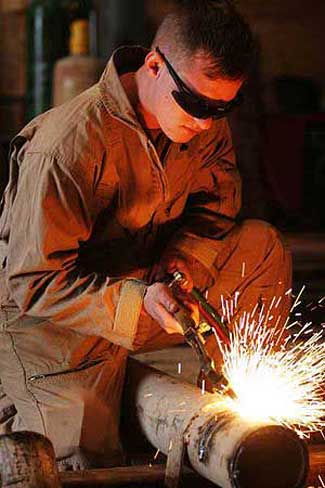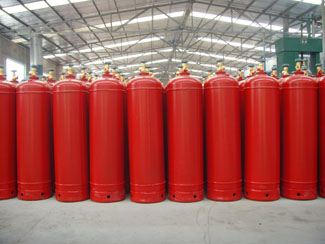Products
Contact Us

Qingdao Ruiming Blue Sky Energy Co. ,Ltd
International sales manager:Sophy
Cell phone:+86-15605422083
Email:sophyruifeng@gmail.com
Skype: sophy19861112
Add: No 1857 Jinshui Road, Licang District, Qingdao, China
Code: 266100
Industrial Gases
Acetylene





• Main Technical Parameter
o Porosoty of porous mass: 90-92%
o Compressive strength of porous mass: ≥1.8 N/nm2
o Yield temperature of fusible plug: 100±5 °C
o utive standard of Filler: GB11638-2003
|
Nominal water capacity
|
40 L
|
|
|
Nominal diameter
|
250 mm
|
|
|
Limited filling pressure(15°C)
|
1.52 Mpa
|
|
|
Hydraulic test pressure
|
5.2 Mpa
|
|
|
Sealing test pressure
|
3 Mpa
|
|
|
Porous mass propery
|
Compressive strength
|
≥1.8 N/nm2
|
|
Porosity
|
90-92%
|
|
|
The axial space
|
≤2.5mm
|
|
|
Solvant
|
Acetone
|
|
|
Acetylene weight
|
Max Filling 6.5KG
|
|
|
Maximum working temperature
|
40 °C
|
|
Application
1. Oxy-Fuel Cutting
Oxy-fuel cutting is a cost-effective method of plate edge preparation for bevel and groove welding. It can be used to easily cut rusty and scaled plates and only requires moderate skill to produce successful results. The oxy-fuel gas cutting process s a chemical reaction of oxygen with the base metal at elevated temperatures to sever the metal. The necessary temperature is maintained by a flame from the combustion of a chooseed fuel gas mixed with pure oxygen.
The process is based on the rapid formation of iron oxide which occurs when a high-pressure pure oxygen stream is introduced into the cutting envelope. The iron is quickly oxidized by the high purity oxygen and heat is liberated by this reaction. The oxygen stream and combusted gas transport the molten oxide away and the metal in its path burns, producing a narrow cut known as a kerf. Continued iron oxide formation requires large volumes of oxygen to be delivered to the cut zone at a controlled preset pressure. The intense heat produced by this reaction sustains the cutting process and the production of the cut.
Common oxy-fuel cutting applications are limited to carbon and low alloy steel. These materials can be cut economically, and the setup is quick and simple. For manual oxy-fuel gas cutting there is no electric power requirement and equipment costs are low. Materials from 1/16in (1.6mm) to 4in (102mm) thick are commonly cut using manual oxy-fuel gas cutting. Materials 12in (0.3m) and greater in thickness are successfully severed using machine cutting.
2. Heat Treating for Automotive & Transportation Equipment
Driven to provide the strength you need
When it comes to finding processes that strengthen your automotive metals, we can help your business race ahead. Heat treating enhances the strength and durability of metals, and we’ll work with you to build the toughest driving machines possible. We offer a diverse portfolio of heat treating applications that can improve the quality and appearance of your metals, make highly reproducible parts and give you better control over your process. Not only that, we can help you find ways to heat treat efficiently, so you never have to choose between cost and quality.